Tire labeling
Overview
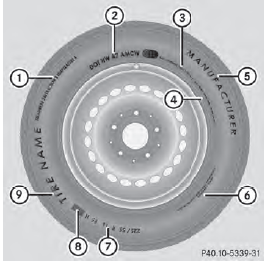
1 Uniform Tire Quality Grading Standard
2 DOT, Tire Identification Number
3 Maximum tire load
4 Maximum tire pressure
5 Manufacturer
6 Tire material
7 Tire size designation, load-bearing capacity and speed index
8 Load index
9 Tire name
The markings described above are on the tire in addition to the tire name (sales designation) and the manufacturer's name.
Tire data is vehicle-specific and may deviate from the data in the example.
Tire size designation, load-bearing capacity and speed rating
WARNING
Exceeding the stated tire load-bearing capacity and the approved maximum speed could lead to tire damage or the tire bursting.
There is a risk of accident.
Therefore, only use tire types and sizes approved for your vehicle model. Observe the tire load rating and speed rating required for your vehicle.
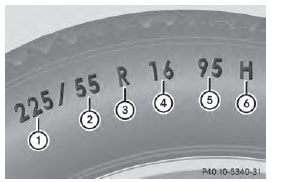
1 Tire width
2 Nominal aspect ratio in %
3 Tire code
4 Rim diameter
5 Load bearing index
6 Speed rating
General: depending on the manufacturer's standards, the size imprinted in the tire wall may not contain any letters or may contain one letter that precedes the size description.
If there is no letter preceding the size description (as shown above): these are passenger vehicle tires according to European manufacturing standards.
If "P" precedes the size description: these are passenger vehicle tires according to U.S.
manufacturing standards.
If "LT" precedes the size description: these are light truck tires according to U.S.
manufacturing standards.
If "T" precedes the size description: these are compact emergency spare wheels at high tire pressure, to be used only temporarily in an emergency.
Tire width: tire width 1 shows the nominal tire width in millimeters.
Height-width ratio: aspect ratio 2 is the size ratio between the tire height and tire width and is shown in percent. The aspect ratio is calculated by dividing the tire width by the tire height.
Tire code: tire code 3 specifies the tire type.
"R" represents radial tires; "D" represents diagonal tires; "B" represents diagonal radial tires.
Optionally, tires with a maximum speed of over 149 mph (240 km/h) may have "ZR" in the size description, depending on the manufacturer (e.g. 245/40 ZR 18).
Rim diameter: rim diameter 4 is the diameter of the bead seat, not the diameter of the rim flange. The rim diameter is specified in inches (in).
Load-bearing index: load-bearing index 5 is a numerical code that specifies the maximum load-bearing capacity of a tire.
Do not overload the tires by exceeding the specified load limit. The maximum permissible load can be found on the vehicle's Tire and Loading Information placard on the B-pillar on the driver's side .
Example: Load-bearing index 91 indicates a maximum load of 1,356 lb (615 kg) that the tires can bear. For further information on the maximum tire load in kilograms and lbs, see .
For further information on the load bearing index, see "Load index" .
Speed rating: speed rating 6 specifies the approved maximum speed of the tire.
Tire data is vehicle-specific and may deviate from the data in the example.
Regardless of the speed rating, always observe the speed limits. Drive carefully and adapt your driving style to the traffic conditions.
Summer tires

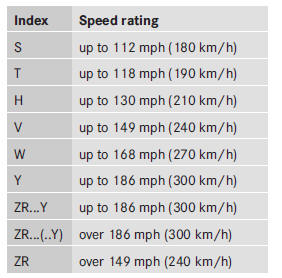
• Optionally, tires with a maximum speed of over 149 mph (240 km/h) may have "ZR" in the size description, depending on the manufacturer (e.g. 245/40 ZR18).
The service specification is made up of load-bearing index 5 and speed rating 6.
• If the size description of your tire includes "ZR" and there are no service specifications, ask the tire manufacturer in order to find out the maximum speed.
If a service specification is available, the maximum speed is limited according to the speed rating in the service specification.
Example: 245/40 ZR18 97 Y. In this example, "97 Y" is the service specification.
The letter "Y" represents the speed rating.
The maximum speed of the tire is limited to 186 mph (300 km/h).
• The size description for all tires with maximum speeds of over 186 mph (300 km/h) must include "ZR", and the service specification must be given in parentheses. Example: 275/40 ZR 18 (99 Y). Speed rating "(Y)" indicates that the maximum speed of the tire is over 186 mph (300 km/h). Ask the tire manufacturer about the maximum speed.
All-weather tires and winter tires
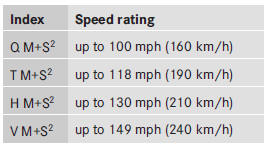
Not all tires with the M+S marking provide the driving characteristics of winter tires.
In addition to the M+S marking, winter tires
also have the  snowflake symbol on
snowflake symbol on
the tire wall. Tires with this marking fulfill
the requirements of the Rubber
Manufacturers Association (RMA) and the
Rubber Association of Canada (RAC)
regarding the tire traction on snow. They
have been especially developed for driving
on snow.
An electronic speed limiter prevents your
vehicle from exceeding the following speeds:
• all vehicles (except AMG vehicles):
130 mph (210 km/h)
• AMG vehicles: 155 mph (250 km/h)
• AMG vehicles with increased top speed:
174 mph (280 km/h)
The speed rating of tires mounted at the factory may be higher than the maximum speed that the electronic speed limiter permits.
Make sure that your tires have the required speed rating, e.g. when buying new tires. The required speed rating for your vehicle can be found in the "Tires" section .
Further information about reading tire data can be obtained from any qualified specialist workshop.
Load index
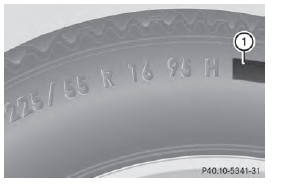
In addition to the load bearing index, load index 1 may be imprinted after the letters that identify the speed index 6 on the sidewall of the tire .
• If no specification is given: no text (as in the
example above), represents a standard
load (SL) tire
• XL or Extra Load: represents a reinforced
tire
• Light Load: represents a light load tire
• C, D, E: represents a load range that
depends on the maximum load that the tire
can carry at a certain pressure
Tire data is vehicle-specific and may deviate from the data in the example.
Maximum load rating
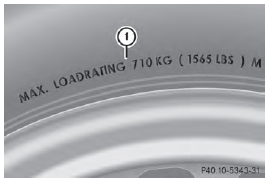
Maximum tire load 1 is the maximum permissible weight for which the tire is approved.
Do not overload the tires by exceeding the specified load limit. The maximum permissible load can be found on the vehicle's Tire and Loading Information placard on the B-pillar on the driver's side .
The actual values for tires are vehiclespecific and may deviate from the values in the illustration.
DOT, Tire Identification Number (TIN)
U.S. tire regulations prescribe that every tire manufacturer or retreader must imprint a TIN in or on the sidewall of every tire produced.

The TIN is a unique identification number. The TIN enables the tire manufacturers or retreaders to inform purchasers of recalls and other safety-relevant matters. It makes it possible for the purchaser to easily identify the affected tires.
The TIN is made up of manufacturer identification code 2, tire size 3, tire type code 4 and manufacturing date 5.
DOT (Department of Transportation): tire symbol 1 indicates that the tire complies with the requirements of the U.S. Department of Transportation.
Manufacturer identification code: manufacturer identification code 2 provides details on the tire manufacturer. New tires have a code with two symbols. Retreaded tires have a code with four symbols.
For further information about retreaded tires, see .
Tire size: identifier 3 describes the tire size.
Tire type code: tire type code 4 can be used by the manufacturer as a code to describe specific characteristics of the tire.
Date of manufacture: date of manufacture 5 provides information about the age of a tire. The first and second positions represent the week of manufacture, starting with "01" for the first calendar week. Positions three and four represent the year of manufacture.
For example, a tire that is marked with "3208", was manufactured in week 32 in 2008.
Tire data is vehicle-specific and may deviate from the data in the example.
Tire characteristics
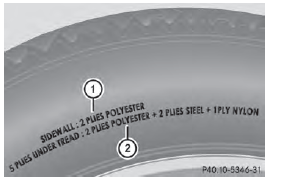
This information describes the type of tire cord and the number of layers in sidewall 1 and under tire tread 2.
Tire data is vehicle-specific and may deviate from the data in the example.
Definition of terms for tires and loading
Tire ply composition and material used
Describes the number of plies or the number of layers of rubber-coated fabric in the tire tread and sidewall. These are made of steel, nylon, polyester and other materials.
Bar
Metric unit for tire pressure.
14.5038 pounds per square inch (psi) and 100 kilopascals (kPa) are the equivalent of 1 bar.
DOT (Department of Transportation)
DOT marked tires fulfill the requirements of the United States Department of Transportation.
Normal occupant weight
The number of occupants which the vehicle is designed for, multiplied by 68 kilograms (150 lb).
Uniform Tire Quality Grading Standards
A uniform standard to grade the quality of tires with regards to tread quality, tire traction and temperature characteristics. Ratings are determined by tire manufacturers using U.S.
government testing procedures. The ratings are molded into the sidewall of the tire.
Recommended tire pressure
The recommended tire pressure applies to the tires mounted at the factory.
The Tire and Loading Information placard contains the recommended tire pressures for cold tires on a fully loaded vehicle and for the maximum permissible vehicle speed.
The tire pressure table contains the recommended pressures for cold tires for various operating conditions, i.e. differing load and speed conditions.
Increased vehicle weight due to optional equipment
This is the combined weight of all standard and optional equipment available for the vehicle, regardless of whether it is actually installed on the vehicle or not.
Rim
This is the part of the wheel on which the tire is mounted.
GAWR (Gross Axle Weight Rating)
The GAWR is the maximum gross axle weight rating. The actual load on an axle must never exceed the gross axle weight rating. The gross axle weight rating can be found on the vehicle identification plate on the B-pillar on the driver's side.
Speed rating
The speed rating is part of the tire identification. It specifies the speed range for which the tire is approved.
GTW (Gross Trailer Weight)
The GTW is the weight of a trailer including the weight of the load, luggage, accessories etc. on the trailer.
GVW (Gross Vehicle Weight)
The gross vehicle weight includes the weight of the vehicle including fuel, tools, the spare wheel, accessories installed, occupants, luggage and the drawbar noseweight, if applicable. The gross vehicle weight must not exceed the gross vehicle weight rating GVWR as specified on the vehicle identification plate on the B-pillar on the driver's side.
GVWR (Gross Vehicle Weight Rating)
The GVWR is the maximum permissible gross weight of a fully loaded vehicle (the weight of the vehicle including all accessories, occupants, fuel, luggage and the drawbar noseweight, if applicable). The gross vehicle weight rating is specified on the vehicle identification plate on the B-pillar on the driver's side.
Maximum loaded vehicle weight
The maximum weight is the sum of: • the curb weight of the vehicle • the weight of the accessories • the load limit • the weight of the factory installed optional equipment
Kilopascal (kPa)
Metric unit for tire pressure. 6.9 kPa corresponds to 1 psi. Another unit for tire pressure is bar. There are 100 kilopascals (kPa) to 1 bar.
Load index
In addition to the load-bearing index, the load index may also be imprinted on the sidewall of the tire. This specifies the load-bearing capacity more precisely.
Curb weight
The weight of a vehicle with standard equipment including the maximum capacity of fuel, oil and coolant. It also includes the airconditioning system and optional equipment if these are installed in the vehicle, but does not include passengers or luggage.
Maximum load rating
The maximum tire load is the maximum permissible weight in kilograms or lbs for which a tire is approved.
Maximum permissible tire pressure
Maximum permissible tire pressure for one tire.
Maximum load on one tire
Maximum load on one tire. This is calculated by dividing the maximum axle load of one axle by two.
PSI (pounds per square inch)
A standard unit of measure for tire pressure.
Aspect ratio
Relationship between tire height and tire width in percent.
Tire pressure
This is pressure inside the tire applying an outward force to each square inch of the tire's surface. The tire pressure is specified in pounds per square inch (psi), in kilopascal (kPa) or in bar. The tire pressure should only be corrected when the tires are cold.
Cold tire pressure
The tires are cold:
• if the vehicle has been parked without
direct sunlight on the tires for at least three
hours and
• if the vehicle has been driven for less than
1 mile (1.6 km).
Tread
The part of the tire that comes into contact with the road.
Bead
The tire bead ensures that the tire sits securely on the wheel. There are several steel wires in the bead to prevent the tire from coming loose from the wheel rim.
Sidewall
The part of the tire between the tread and the bead.
Weight of optional extras
The combined weight of those optional extras that weigh more than the replaced standard parts and more than 2.3 kilograms (5 lbs).
These optional extras, such as highperformance brakes, level control, a roof rack or a high-performance battery, are not included in the curb weight and the weight of the accessories.
TIN (Tire Identification Number)
This is a unique identifier which can be used by a tire manufacturer to identify tires, for example for a product recall, and thus identify the purchasers. The TIN is made up of the manufacturer's identity code, tire size, tire type code and the manufacturing date.
Load bearing index
The load bearing index (also load index) is a code that contains the maximum load bearing capacity of a tire.
Traction
Traction is the result of friction between the tires and the road surface.
TWR (Tongue Weight Rating)
The TWR specifies the maximum permissible weight that the ball coupling of the trailer tow hitch can support.
Treadwear indicators
Narrow bars (tread wear bars) that are distributed over the tire tread. If the tire tread is level with the bars, the wear limit of á in (1.6 mm) has been reached.
Occupant distribution
The distribution of occupants in a vehicle at their designated seating positions.
Total load limit
Rated cargo and luggage load plus 68 kilograms (150 lb) multiplied by the number of seats in the vehicle.
See also:
Recovering a vehicle that has become
stuck
Pull away smoothly, slowly, and in a
straight line when pulling out a vehicle that
has become stuck. Excessive tractive
power could damage the vehicles.
If the drive wheels get trapped on loose ...
Switching the seat heating on/off
General notes
WARNING
Repeatedly setting the seat heating to level
3 may result in excessive seat temperatures.
The health of passengers that have limited
temperature sensitivity or a limited a ...
Symbols
Registered trademarks:
• Bluetooth® is a registered trademark of
Bluetooth SIG Inc.
• DTS is a registered trademark of DTS, Inc.
• Dolby and MLP are registered trademarks
of DOLBY Laboratories.
...
